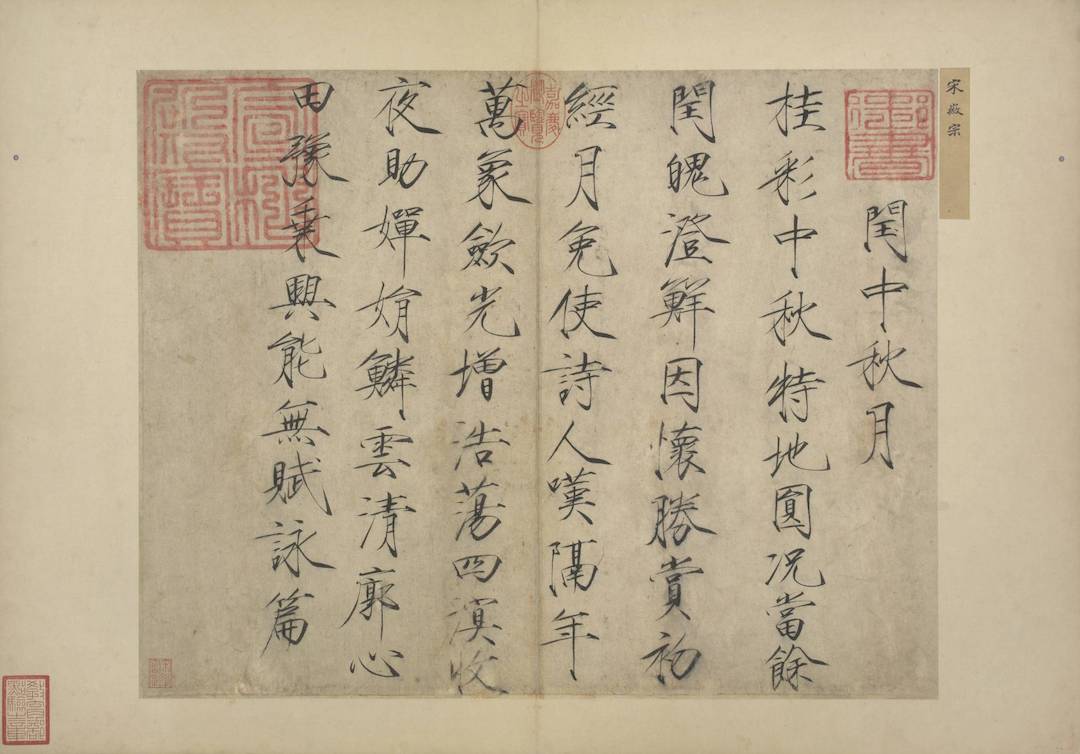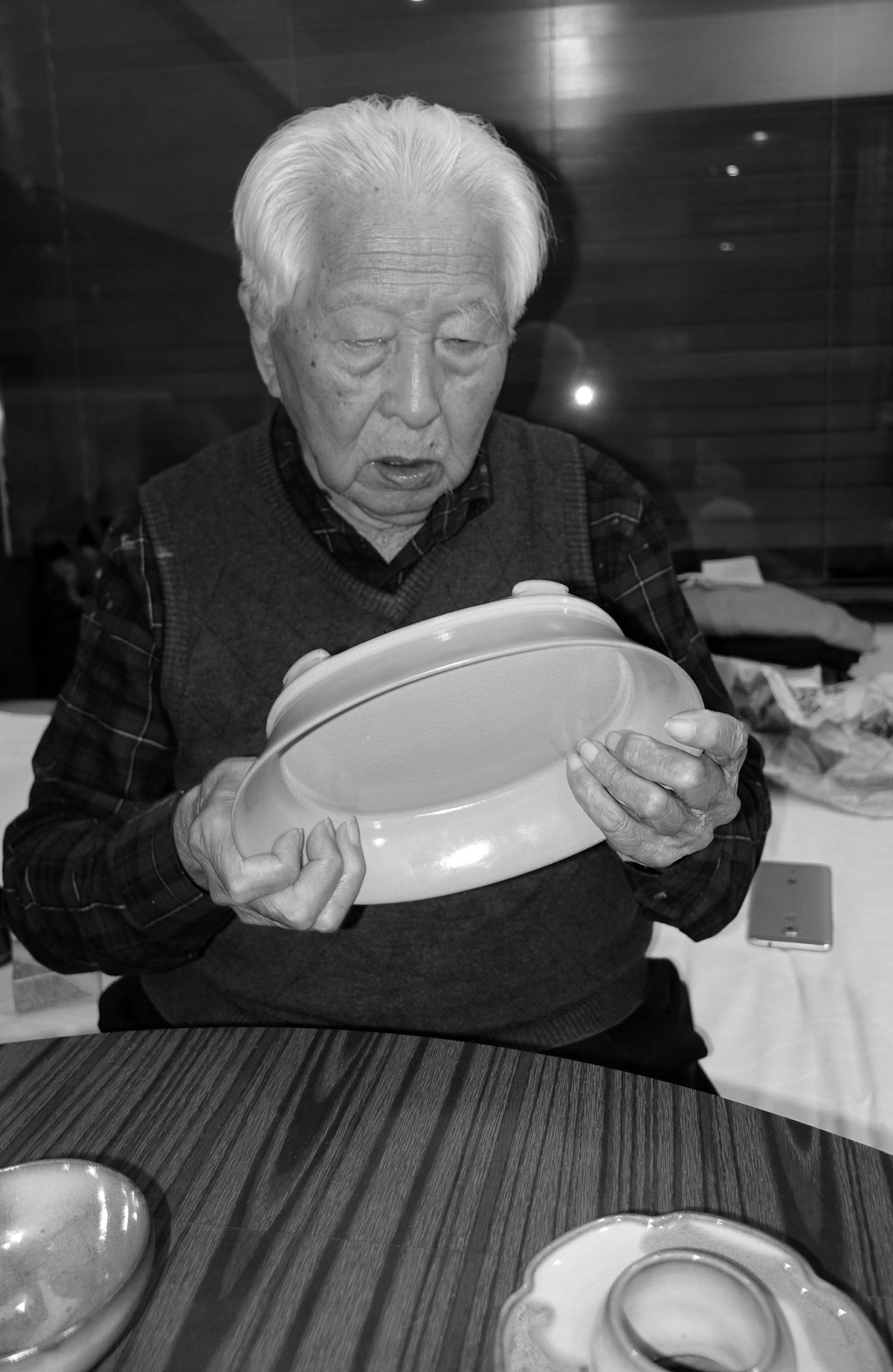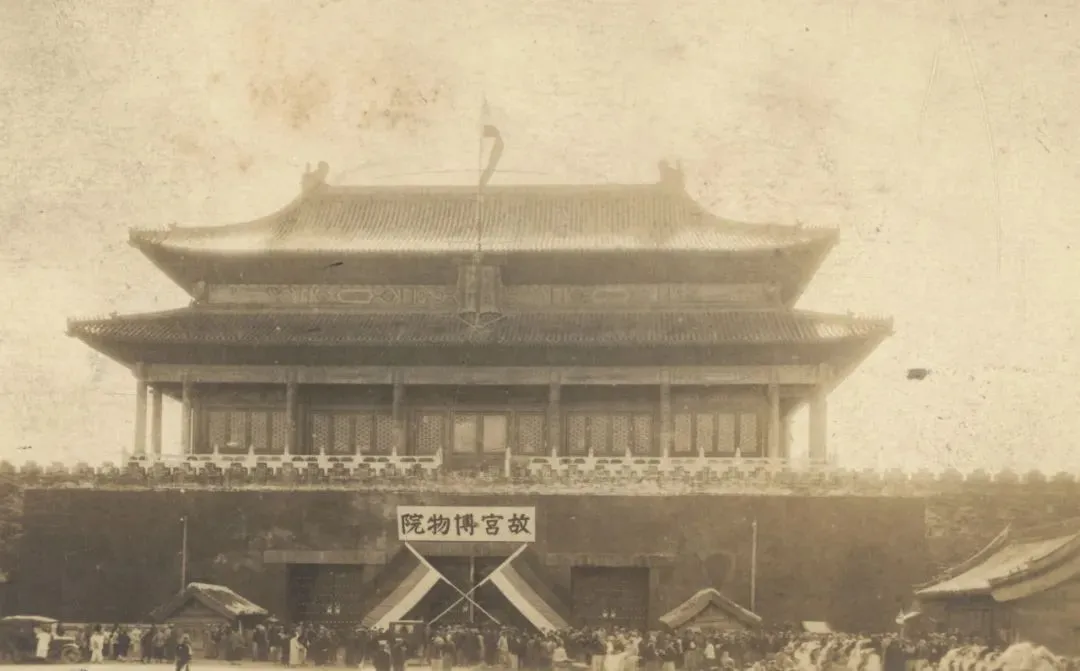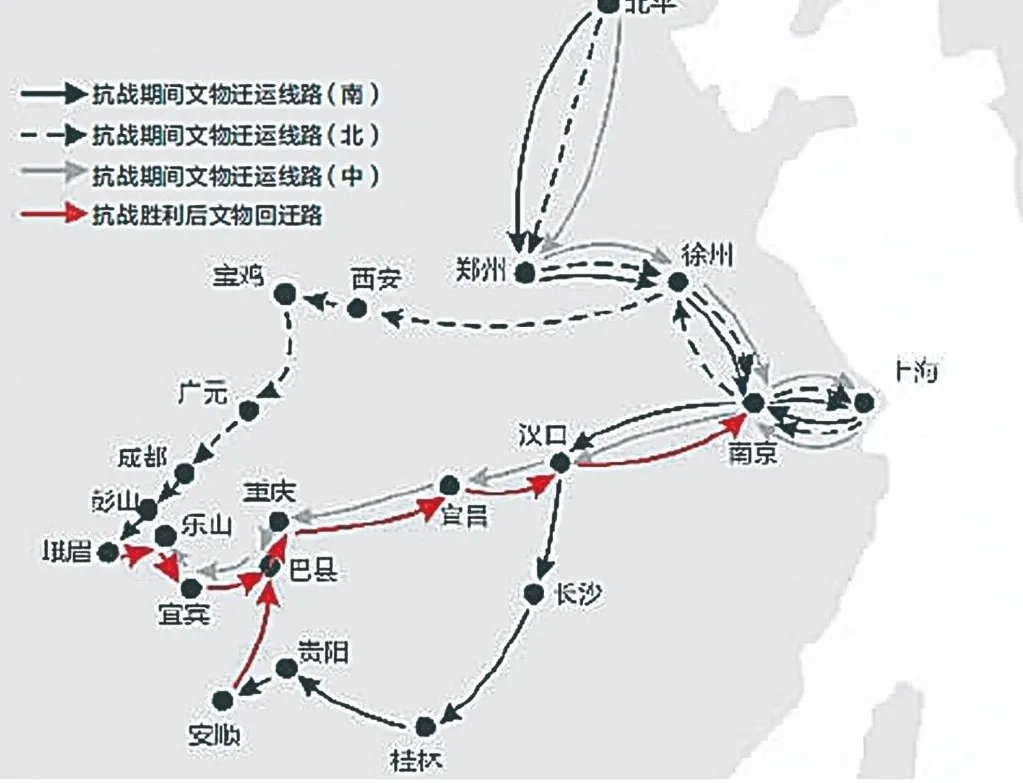
The “Palace Museum·Tea World” Tea Viewing – Tea Culture Cultural Relics Exhibition” will open on January 10 at the Zhejiang Provincial Museum. The exhibition focuses on the two peak eras of the development of Chinese tea culture – Song and Qing, and weaves a gorgeous picture of tea with “Song people and tea” and “Qing people and tea” as the context.
On January 7, The Paper saw at the exhibition that famous works by Emperor Huizong of Song Dynasty, including "Zhao Ji's Regular Script Poem on the Leap Mid-Autumn Moon", "Zhao Ji's Painting of Loquats and Mountain Birds", "Zhao Ji's Regular Script Poems on Deutzia Flowers and Bamboo Shoots and Stones", as well as famous manuscripts by the "Four Masters of Song Dynasty" Su Shi, Huang Tingjian, Mi Fu, and Cai Xiang, "Lin Bu's Running Script Self-Written Poems", the "Great Sage's Legacy" guqin, and exquisite porcelains from the five famous kilns that are closely related to tea affairs will all be gathered in the Zhejiang Museum exhibition hall.

Zhao Ji's Regular Script Poem on the Leap Year Mid-Autumn Moon
"This exhibition does not showcase a single tea culture, but connects many threads through tea, such as the eight arts of ancient people, 'qin, chess, calligraphy, painting, poetry, wine, flowers and tea.' Through authentic calligraphy and painting, precious artifacts, surviving tribute tea, rare ancient books and other tea-related cultural relics and stories about people, it connects a world centered on tea." At the exhibition site yesterday, Guo Tao, head of the "Forbidden City Tea World" tour department, told The Paper.

At the exhibition, the Song Dynasty anonymous painting "Flower Painting by Song People" was displayed in an independent space

Exhibition site: "Flower Paintings by Song Dynasty Artists"
Entering the exhibition hall, a painting titled "Flower Paintings by Song Dynasty Artists" opens the exhibition. This "Flower Paintings" by an anonymous artist from the Song Dynasty is displayed in an independent space. As you walk from far to near, you can feel the elegant and quiet atmosphere conveyed by Song Dynasty paintings. On the left side of the painting, two blooming flowers are drooping slightly, and on the right side is a small bud about to bloom. The composition of the painting is simple but not thin, reflecting the simple aesthetics of the Song Dynasty artists. The flowers and leaves are clearly layered and nestle together.

"Flower Paintings by Song Dynasty"
"Behind this work, we can see the prosperity of flower affairs in the Song Dynasty. The eight arts of ancient people were playing music, chess, calligraphy, painting, poetry, wine, flowers and tea. Flower affairs, like tea affairs, were an important part of ancient people's lives." The exhibition opens with Song Dynasty paintings collected by the Palace Museum, showing the artistic pursuit and life aesthetics of tea affairs in the Song Dynasty.

Zhao Ji's painting of loquats and mountain birds
Tea culture flourished in the Song Dynasty, with many famous tea scholars and masters emerging. The involvement of the court and the scholar class greatly enhanced the connotation of tea culture, which then spread from the upper level to the common people, creating a unique cultural connotation and aesthetic taste for the Chinese lifestyle and spiritual world.

The installation leading to the exhibition hall is like the opening of the gate of the Forbidden City.
Tea tasting and playing the guqin have been an elegant companion that complements each other since ancient times. The "Dasheng Yiyinqin", a Tang Dynasty guqin collected by the Palace Museum, and the surviving tribute tea exhibited in the same space face each other, creating an elegant atmosphere and connecting the past and the future.

The exhibition site of the Tang Dynasty Guqin "Dasheng Yiyinqin"

The exhibition site of the Tang Dynasty Guqin "Dasheng Yiyinqin"
The Tang Dynasty guqin "Dasheng Yiyin Qin" is a Tang Dynasty guqin called "the greatest treasure" by the Palace Museum. This is the first time it has been exhibited outside the palace, and the exhibition will only last for one month. On the guqin pool, there are four characters written in cursive script in gold lacquer, which is the name of the guqin. On both sides of the guqin pool, there are inscriptions in official script: "The huge ravine welcomes the autumn, the cold river reflects the moon. The myriad sounds are long, and the solitary tung tree is cracking." These 16 characters describe the state of the guqin when it is played. On both sides of the inner pool of the guqin, there are inscriptions in official script in red lacquer, "Zhide Bingshen", which is an important basis for dating this guqin to the Tang Dynasty. "Zhide Bingshen" was the second year of the "Anshi Rebellion". Crown Prince Li Heng ascended the throne in Lingwu and changed the reign to Zhide. This year was called Zhide Yuanzai (i.e. Zhide Bingshen Year). Based on this, it is speculated that this guqin may be a ceremonial instrument made to congratulate the new king on his accession to the throne.

The precious tribute tea from the Qing Dynasty on display at the Palace Museum
Facing the Tang Dynasty zither is the precious tribute tea from the Qing Dynasty in the Palace Museum. "The development of Chinese tea culture has gone through thousands of years, and the tribute tea system has a long history, but the Qing Dynasty is the only period in which tribute tea remains." The guide expert of the exhibition said. This exhibition displays more than ten kinds of precious tribute tea from the Qing Dynasty in the Palace Museum, from Longjing bud tea, Longjing tea, ginseng tea paste, Yangxian tea, Biluochun tea to Chunming tea, etc. These Qing Dynasty tribute teas in tin tea cans and wooden boxes are all precious, and Longjing tea is produced in Zhejiang.

Longjing Tea from the Qing Dynasty

Qing Dynasty Biluochun Tea

Qing Dynasty Spring Tea
The calligraphy work "Lin Bu's Self-Written Poems in Running Script" from the Song Dynasty is also a major work in this exhibition. Like the "Great Sage's Harp", it is the first time to be exhibited outside the palace. The exhibition will last for one month. This cultural relic is also one of the 195 cultural relics prohibited from leaving China. The content on the cultural relic is even more interesting. It can be said that a piece of calligraphy connects the stories of three famous figures in history.

Lin Bu's Poems in Running Script
Lin Bu, also known as Mr. Hejing, was a native of Qiantang, Zhejiang, which is today's Hangzhou, Zhejiang. As a hermit poet in the Northern Song Dynasty, he lived in seclusion on Gushan Mountain in West Lake, married plum blossoms and had cranes as his sons. He was known as "plum wife and crane son". He could be said to be the first person to oppose involution at that time.
Lin Bu's Self-written Poems in Running Script contains five poems written by himself. "The poems are clear and elegant, the calligraphy is wide and sparse, the characters are strong and vigorous, and the style is square, hard, cold and sharp, but elegant and refined." It is his representative work handed down from generation to generation. Although Su Shi and Lin Bu had never met, because Lin Bu had died when Su Shi was born, Su Shi regarded Lin Bu as his idol in life and admired Lin Bu's poetic talent and character. He praised Lin Bu's elegance and noble character and his poetic style and calligraphy in the postscript at the end of the scroll.

The "Lin Bu's Running Script Self-Written Poems" on display (partial) Su Shi's postscript to the scroll
At the back of the scroll is an inscription by Emperor Qianlong, an important tea lover. Emperor Qianlong loved the scenery of Jiangnan and brought Lin Bu's calligraphy with him on his six trips to Jiangnan. He also made sure to visit the Crane-releasing Pavilion on Gushan Mountain where Lin Bu lived during his lifetime.

The scroll of Lin Bu's self-written poems in running script (partial) on display. The inscription by Emperor Qianlong at the end of the scroll
This volume of works contains not only the excellent works of Lin and Su, but also the inscriptions and seals of Emperor Qianlong. It is very interesting to read carefully, and it also has a wonderful connection with Hangzhou.

Mi Fu's calligraphy of Huatai Poems

Huang Tingjian's Regular Script Poems for His Forty-Nine Nephews

Cai Xiang's Spring Calligraphy
When talking about "Song people and tea", we can't avoid the relationship between the Four Masters of Song Dynasty and tea. From historical data, we know that the Four Masters of Song Dynasty all had a connection with tea. Cai Xiang made small round tea and wrote "Cha Lu", which led the fashion. Su Shi and Huang Tingjian loved tea and sang about tea, and produced many excellent works. Mi Fu drank tea to meet friends. The Four Masters used tea to soothe their hearts, and tea culture flourished.

Ming and Qing Dynasty "Su Shi (biography) Running Script Dinghuiyuan Two Poems Draft Volume"
The exhibition displays original calligraphy works of four Song Dynasty calligraphers, including Mi Fu's Calligraphy of Huatai Poems, Huang Tingjian's Running and Regular Script of Poems to Forty-Nine Nephews, Cai Xiang's Running Script of Ruchun, and Su Shi's (attributed) Running Script of Two Poems to Dinghuiyuan, to show how tea became the spiritual sustenance of Song Dynasty literati, the source of inspiration for their artistic life, and an important part of social activities.

Tang Yin's Tea Scroll (Partial) Ming Dynasty, Collection of the Palace Museum

Tang Yin's Tea Scroll (Partial) Ming Dynasty, Collection of the Palace Museum
The Ming Dynasty "Tang Yin's Painting of Tea" on display depicts the life of literati and scholars drinking tea. In the foreground, there are huge rocks standing sideways, and in the distance, there are mountains and waterfalls, and the house is in the valley. Inside the house, someone is reading at the desk, and there are tea sets on the desk. A boy is brewing tea. Outside the house, an old man is walking with a cane, followed by a boy holding a zither. Tang Yin also wrote a poem himself, "What can I do in the long days? I carry the tea bowl by myself. I expect that under the south window, the breeze fills my hair", embedding his friend's name "Shiming" in it.

Northern Song Dynasty Ru kiln celadon glaze round washbasin

Southern Song Dynasty official kiln green glaze sunflower-shaped bowl

Northern Song Dynasty Ding kiln white glaze saucer
Teaware is a witness to the prosperity of tea culture. From the simple and elegant Song Dynasty teaware to the exquisite and gorgeous Qing Dynasty teaware, they all reflect the tea drinking style and aesthetic taste of people at that time. Song porcelain, with its outstanding artistic achievements and unique aesthetic value, occupies an important position in the history of Chinese and even world ceramics. The exhibition displays the five famous kilns of Guan, Ge, Ru, Ding and Jun, as well as the most representative porcelain treasures of the Tang, Ming and Qing dynasties, reproducing the evolution and characteristics of tea drinking methods and porcelain firing in different eras.

Qing Dynasty Yongzheng Doucai Chicken Cup

Jian kiln black glaze rabbit hair cup

Ming Longquan kiln green glaze carved "fragrant wine" lidded jar
The Qing Dynasty was another peak in the development of tea culture. On the one hand, the variety of tea increased and was exported to all parts of the world, and tea drinking became a global trend. On the other hand, the tea-making method of the Ming Dynasty was followed and simplified, and tea entered all aspects of life from the palace to the local areas. The exhibition also presents the richness and refinement of the Qing Dynasty court tea affairs, focusing on the collection of Emperor Qianlong's tea-related calligraphy and paintings and utensils, presenting the Qing Dynasty court tea culture that integrates the culmination of past dynasties and the integration of nationalities.

Anonymous painting of Yinzhen enjoying himself (Part 1)

Copper body painted enamel openwork landscape flower-bird pattern octagonal handle pot
The exhibition is jointly organized by the Palace Museum and Zhejiang Provincial Museum. A total of 114 pieces (sets) of precious cultural relics and related historical materials from the Palace Museum are on display, covering authentic paintings and calligraphy, precious artifacts, surviving tribute tea, and rare ancient books. The exhibition takes the "Celebrate the New Year in the Museum" event held by Zhejiang Provincial Museum as a new starting point, and the exhibition will last from January 10 to April 6, 2025.

Zhao Ji's Regular Script Poems on the Flower of Dianthus and the Bamboo Shoot and Stone

Exhibition poster
(Note: Some cultural relics are on display for a limited time; this exhibition is a paid exhibition, ticket information can be found on the official WeChat public account)
*For the protection of cultural relics, some paintings and calligraphy relics are only on display for one month
First issue
"Flower Paintings by Song Dynasty"
Lin Bu's Poems in Running Script
"Draft of Two Poems of Dinghuiyuan in Running Script by Su Shi (Biography)"
Huang Tingjian's Poems in Running and Regular Script for His Forty-Nine Nephews
Mi Fu's Huatai Poetry Calligraphy
"Cai Xiang's Running Script Spring Postscript"
Second issue
Zhao Ji's Regular Script Poem on the Leap Year Mid-Autumn Moon
"Song Dynasty Copy of Lu Hong's Ten Anecdotes of Caotang"
Third issue
Zhao Ji's painting of loquats and mountain birds
Zhao Ji's Regular Script Poems on the Flower of Dianthus and the Bamboo Shoot and Stone


